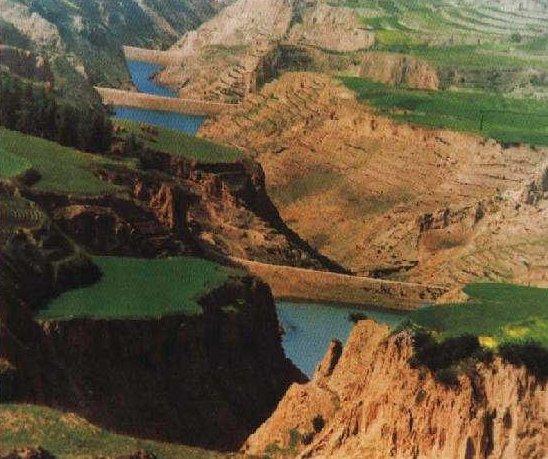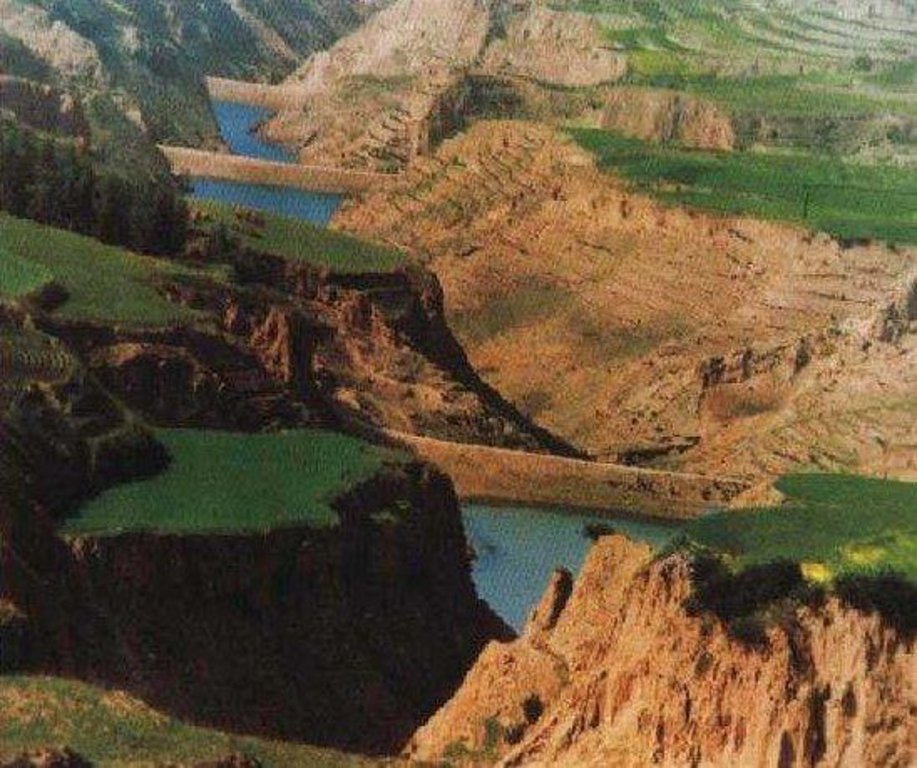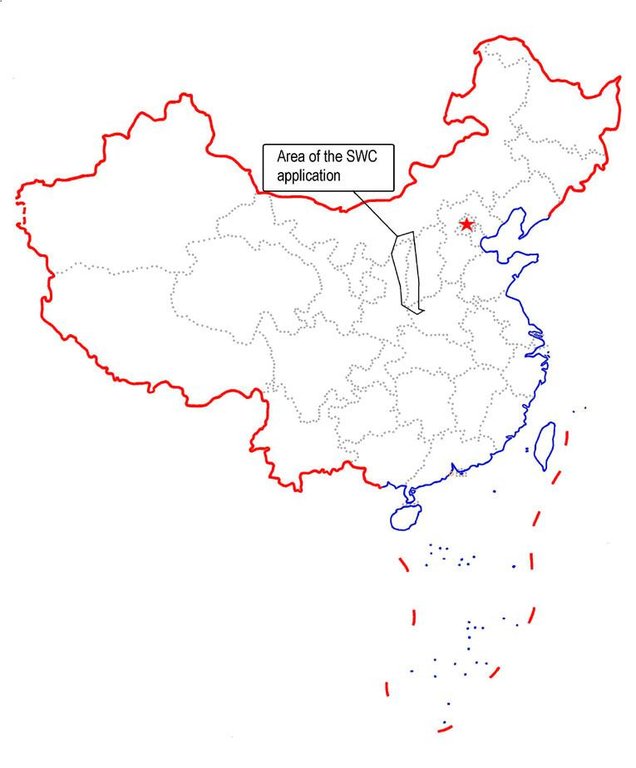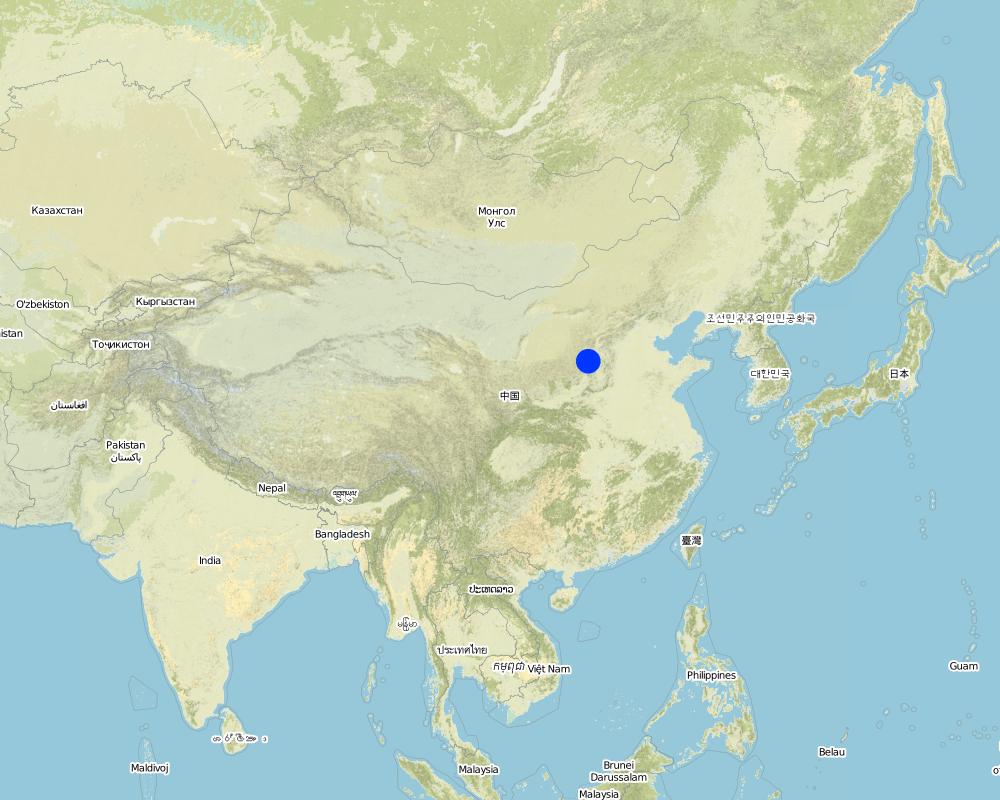Falling Water Dam [China]
- Creation:
- Update:
- Compiler: Yan ZHANG
- Editor: –
- Reviewer: Laura Ebneter
approaches_2400 - China
View sections
Expand all Collapse all1. General information
1.2 Contact details of resource persons and institutions involved in the assessment and documentation of the Approach
SLM specialist:
Name of the institution(s) which facilitated the documentation/ evaluation of the Approach (if relevant)
Department of Resources and Environmental Science, Beijing Normal University (Department of Resources and Environmental Science, Beijing Normal University) - China1.3 Conditions regarding the use of data documented through WOCAT
The compiler and key resource person(s) accept the conditions regarding the use of data documented through WOCAT:
Yes
1.4 Reference(s) to Questionnaire(s) on SLM Technologies
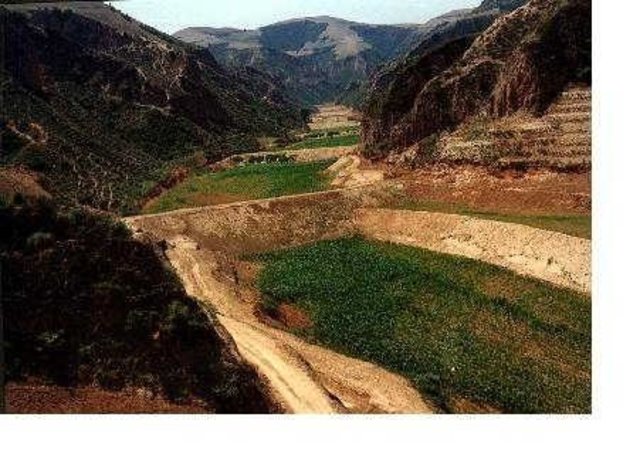
Auto-Flowing Slurry Dam [China]
Auto-flowing slurry dams is filled with dense slurry by water flow from upland to maintain eroded soil particles and runoff.
- Compiler: Yan ZHANG
2. Description of the SLM Approach
2.1 Short description of the Approach
The falling water dams are widely built in the middle reach of the Yellow River, the typical dams are filled with dense slurry by water flow from upland. The approach is implemented mainly by government investment.
2.2 Detailed description of the Approach
Detailed description of the Approach:
Falling water filled dams distribute widely in the middle reaches of the Yellow River. They are used to store water, wrap sediment which results from soil and water loss. On the Loess Plateau, in addition to the conditions of deep gully and steep slope, earth above the top of the dams can be used to build dams. First, soil is loosed with squirt guns, explosion or manually digging. Then, water is pumped up to the loose earth so as to rush the soil down along transporting ditch, turning the soil into dense mud, to dams level surrounded by tamped banks. Under the press of gravity, the mud dehydrates, consolidates and becomes uniformly dense body of the dams. Compared with dams in other areas, the water power filled dams in the Yellow River basin are characterized by much denser mud, uniform particles and body texture, smaller transect of dams body, and wide applicability to soil materials such as sand soil, loess soil and weathering residue. The types of dams have widely applied to build middle and small reservoirs and silt arresters in the middle reaches of the Yellow River, playing an important role in agricultural production and reduction of sediment into the Yellow River.
2.3 Photos of the Approach
2.5 Country/ region/ locations where the Approach has been applied
Country:
China
Region/ State/ Province:
Shanxi, Shaanxi, etc.
Map
×2.6 Dates of initiation and termination of the Approach
Indicate year of initiation:
1950
Year of termination (if Approach is no longer applied):
2005
2.7 Type of Approach
- traditional/ indigenous
2.8 Main aims/ objectives of the Approach
The objectives of the approach are to control soil & water loss so as to reduce flood; to make more crop land.
The SLM Approach addressed the following problems: The main existing issues are unreasonable land use planning and low use rate; Lower standard of SWC design and poor quality in construction which would lead to flood danger; low administrative level and economic benefits.
2.9 Conditions enabling or hindering implementation of the Technology/ Technologies applied under the Approach
availability/ access to financial resources and services
- hindering
Only when government invests, the technology can be implemented
Treatment through the SLM Approach: investment
legal framework (land tenure, land and water use rights)
- enabling
The existing land ownership, land use rights / water rights helped a little the approach implementation: Because land resources belongs to state and land user can lease the land.
3. Participation and roles of stakeholders involved
3.1 Stakeholders involved in the Approach and their roles
- national government (planners, decision-makers)
- international organization
3.2 Involvement of local land users/ local communities in the different phases of the Approach
| Involvement of local land users/ local communities | Specify who was involved and describe activities | |
|---|---|---|
| initiation/ motivation | self-mobilization | rapid/participatory rural appraisal; The approach is a traditional way to harvest water and wrap soils, SWC applied land users easy to understand and accept it if some subsidy being obtained. |
| planning | interactive | workshops/seminars; After a program granted, implementing agency and local communities working together. |
| implementation | external support | responsibility for major steps; In practice, local communities are the major part to manager and carry out. |
| monitoring/ evaluation | passive | interviews/questionnaires; When monitoring procedures are clear, the local communities could do this and evaluate. |
| Research | interactive | Only can give some suggestions or questionnaire. |
3.4 Decision-making on the selection of SLM Technology/ Technologies
Specify who decided on the selection of the Technology/ Technologies to be implemented:
- politicians/ leaders
Explain:
Decisions on the choice of SLM Technology were made directive (top-down).
Decisions on the method of implementing the SLM Technology were made by by politicians / leaders (directive, top-down).
4. Technical support, capacity building, and knowledge management
4.1 Capacity building/ training
Was training provided to land users/ other stakeholders?
Yes
Specify who was trained:
- land users
Form of training:
- farmer-to-farmer
- demonstration areas
Subjects covered:
How to maintain and reinforce the dams
4.2 Advisory service
Do land users have access to an advisory service?
Yes
Specify whether advisory service is provided:
- at permanent centres
Describe/ comments:
Name of method used for advisory service: Falling water dam show; Key elements: Selection of site for dam building, size of dam, materials and methods; 1) Mainly: projects own extension structure and agents, Partly: government's existing extension system 2) Mainly: projects own extension structure and agents, Partly: government's existing extension system; Extension staff: mainly government employees 3) Target groups for extension: land users; Activities: demonstration
Advisory service is quite adequate to ensure the continuation of land conservation activities; At each government level, there is a SWC office which is in charge of SWC activities including extension.
4.3 Institution strengthening (organizational development)
Have institutions been established or strengthened through the Approach?
- yes, greatly
Specify the level(s) at which institutions have been strengthened or established:
- local
Specify type of support:
- financial
- capacity building/ training
- equipment
4.4 Monitoring and evaluation
Is monitoring and evaluation part of the Approach?
Yes
Comments:
area treated aspects were ad hoc monitored through measurements
land users involved aspects were ad hoc monitored through measurements
There were few changes in the Approach as a result of monitoring and evaluation
4.5 Research
Was research part of the Approach?
Yes
Specify topics:
- ecology
- technology
Give further details and indicate who did the research:
Pattern and standards for the dam design.
Research was carried out both on station and on-farm
5. Financing and external material support
5.1 Annual budget for the SLM component of the Approach
If precise annual budget is not known, indicate range:
- > 1,000,000
Comments (e.g. main sources of funding/ major donors):
Approach costs were met by the following donors: government (national - The central government): 85.0%; local community / land user(s) (Village committee): 5.0%; other (World Bank): 10.0%
5.3 Subsidies for specific inputs (including labour)
- equipment
| Specify which inputs were subsidised | To which extent | Specify subsidies |
|---|---|---|
| machinery | fully financed | subsidy |
- infrastructure
| Specify which inputs were subsidised | To which extent | Specify subsidies |
|---|---|---|
| community infrastructure | fully financed | financed by government |
If labour by land users was a substantial input, was it:
- voluntary
Comments:
If managed by administrative way, land users' input are mainly voluntary, if through a project, usually paid in cash.
5.4 Credit
Was credit provided under the Approach for SLM activities?
Yes
Specify conditions (interest rate, payback, etc.):
Interest rate charged: 4.0%; repayment conditions: After 4 or 5 years when SWC produces benefits, loaner should return.
Interest was lower than market rate.
6. Impact analysis and concluding statements
6.1 Impacts of the Approach
Did the Approach help land users to implement and maintain SLM Technologies?
- No
- Yes, little
- Yes, moderately
- Yes, greatly
They can harvest water and irrigate crops in dry seasons. Meanwhile, more crop land area is made.
Did the Approach improve issues of land tenure/ user rights that hindered implementation of SLM Technologies?
- No
- Yes, little
- Yes, moderately
- Yes, greatly
The policies of land contract distribute land to individuals so that land users who involved in SWC activities need to be organized together for implementation of the SWC. The organization need much time and hard work. The problem is likely to be overcome in the near future. Administrative management can adjust and assort with this issue.
Did other land users / projects adopt the Approach?
- No
- Yes, little
- Yes, moderately
- Yes, greatly
6.3 Sustainability of Approach activities
Can the land users sustain what has been implemented through the Approach (without external support)?
- yes
6.4 Strengths/ advantages of the Approach
| Strengths/ advantages/ opportunities in the land user’s view |
|---|
| Raising crop production and return (How to sustain/ enhance this strength: applying fertilizers as possible as can) |
| water can be irrigated in dry seasons and drinks both for cattle and man (How to sustain/ enhance this strength: maintaining and repairing if needed.) |
| Strengths/ advantages/ opportunities in the compiler’s or other key resource person’s view |
|---|
| Storing water (How to sustain/ enhance this strength: reducing vapour and leak as possible as can) |
| Enlarge cropland and raising yield (How to sustain/ enhance this strength: shifting food crops to cash crops) |
| reducing flooding (How to sustain/ enhance this strength: reinforce the dams timely) |
6.5 Weaknesses/ disadvantages of the Approach and ways of overcoming them
| Weaknesses/ disadvantages/ risks in the land user’s view | How can they be overcome? |
|---|---|
| Costly and frenquently reinforce |
| Weaknesses/ disadvantages/ risks in the compiler’s or other key resource person’s view | How can they be overcome? |
|---|---|
| The dams' quality are not high | standardization for design and construction |
7. References and links
7.1 Methods/ sources of information
- field visits, field surveys
- interviews with land users
7.2 References to available publications
Title, author, year, ISBN:
Special Planning Of Soil And Water Conservation in Xinzhou Region , Shanxi Province, 1986-1990
Available from where? Costs?
Library of the Resource and Environmental Department, Beijing Normal University.
Title, author, year, ISBN:
How to design the dry masonry dam in the Hanjiachuan watershed. Tianyuzhu, Wangzuliang. Beijing. Water conservation in Beijing, 2000
Available from where? Costs?
Library of the Resource and Environmental Department, Beijing Normal University.
Links and modules
Expand all Collapse allLinks

Auto-Flowing Slurry Dam [China]
Auto-flowing slurry dams is filled with dense slurry by water flow from upland to maintain eroded soil particles and runoff.
- Compiler: Yan ZHANG
Modules
No modules


